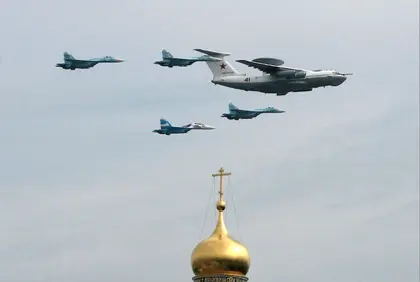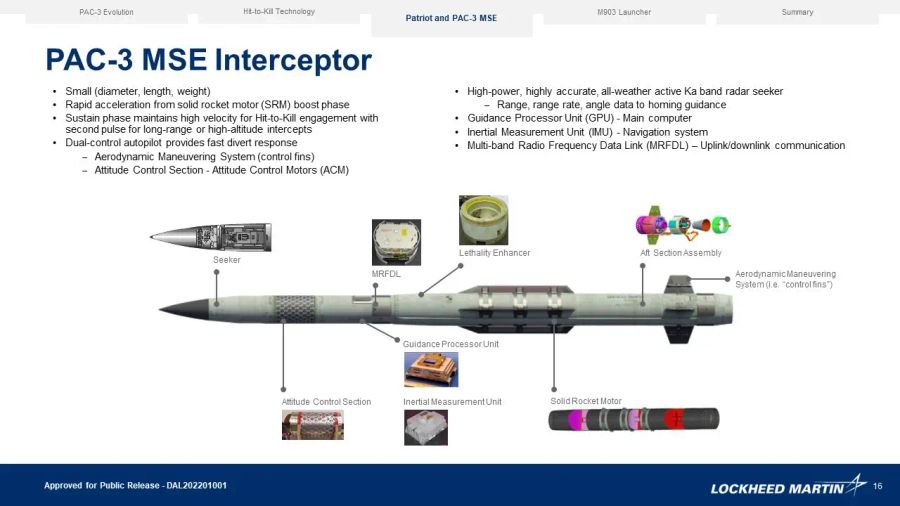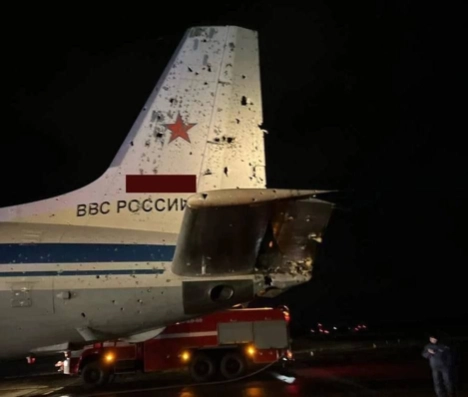More evidence is surfacing that the Kremlin’s embarrassing Sunday loss of a pair of expensive command and reconnaissance aircraft was the result of a Ukrainian missile ambush, most likely multiple US-made Patriot missiles fired from a location near the front lines.
Voice recordings of Russian service personnel identified by the Ukrainian military as two pilots in a pair of Su-34 fighter jets operating over the Sea of Azov, and a ground control station, suggest the Ukrainian military shot at them but missed.
JOIN US ON TELEGRAM
Follow our coverage of the war on the @Kyivpost_official.
“The missile went by me,” one pilot said. “The stick (Russian air force slang for “missile”) when it appeared, in the middle of the screen, came from the other side… Speed was 3,600 (kph), altitude was about 12-15 thousand (meters).
Kyiv Post was not able to confirm Ukrainian military claims that the recordings were made on Sunday minutes after the Russian air force lost an A-50 AWACs plane over the Sea of Azov, and an Il-22M command and control plane suffered substantial damage from a missile hit, but a Kyiv Post verification team – one a former military pilot – reviewed the recordings and found them consistent with typical Russian combat pilot communications.
In the transcript – which can be read in full at the end of this article – one Russian pilot suggests the incoming weapon evaded was a Russian-made S-300 missile fired by Ukrainian forces, not a Patriot.

Orban Slams Ukraine’s ‘Hostile’ Statements, Threatens ‘Countermeasures’
‼️🇷🇺Прошёл рядом на пределе: Су-34 ушёл от вражеской ракеты — радиоперехват
— Magelan Z_O_V_ (@Operativnik22) January 15, 2024
▪️Сегодня вражеские ресурсы полдня писали, что на границе Запорожской и Днепропетровской областей якобы пропал с радаров = был сбит истребитель-бомбардировщик Су-34. pic.twitter.com/kFTa0MQRm1
The Armed Forces of Ukraine (AFU) confirmed the destruction of both aircraft, claiming the Il-22M, though able to return to its base, was no longer flyable. AFU sources have declined to say how they shot the two high tech Russian planes valued at close to $400 million down.
Among Ukrainian military commentators, speculation has been wide that the AFU secretly deployed a US-made Patriot missile system near the shooting front to achieve the intercepts, reaching into air space considered safe by the Russian air force by positioning the American system dangerously close to fighting lines.
Research made public by the Ukrainian military research group Defence Express on Monday found that, based on the public domain-reported range of Patriot PAC-3 missiles known to be operated by the AFU, were Kyiv to have found a way to securely deploy a Patriot launcher within 15 kilometers of the fighting line, the Russian aircraft would probably have been just inside the PAC-3 real range, albeit the Patriot launchers would have likewise been dangerously within the range of a Russian artillery counterstrike.
“Patriot is certainly the most likely way the shoot down took place… the 160 kilometer range is a ‘declared’ [number],” the report said in part.
Best known in Ukraine as an advanced air defense system capable of shooting down ballistic missiles aimed at Ukrainian cities, some versions of the American Patriot missile, if fired at airplanes, intercept targets and uses technologies to destroy them, differently from most legacy era air defense systems.
According to the US military information platform War Zone, if a PAC-3 Patriot missile – the latest version of the weapon – is launched at an aircraft rather than a ballistic missile, the missile’s onboard computer guides the weapon to the near to the closest possible point to intercept the airplane, and then detonates a “lethality enhancer” built around the warhead, scattering a shotgun-like blast of metal fragments ahead of the target.
As designed, the donut-shaped lethality enhancer once the Patriot’s warhead detonates sends a cone-shaped cloud of steel or tungsten projectiles, called “cycloids”, into the path of the aircraft. There are 24 cycloids each weighing 95 grams in the warhead. The warhead itself, reportedly, contains about 330 grams of explosive.
That projectile cloud, and other debris from the Patriot thrown into the air at supersonic speeds following the warhead’s detonation, is designed to intercept a modern combat aircraft much the same way a hunter hopes his accurately-aimed 12 gauge shotgun shot will knock down a flying duck, a detailed article published June 2023 by War Zone explained.
Images of a Russian Il-22M confirmed by both Russian and Ukrainian sources to be photographs of the damaged aircraft after it landed in Anapa showed clear signs of tail damage from a relatively narrow fragmentation cloud, and effectively no evidence of major blast damage.
However, according to open sources, the PAC-3 Patriot missile has an advertised range of 70 km., meaning either a PAC-3 could not have hit the Russian planes over the Sea of Azov, or actual effective ranges of the American weapon are almost double ranges reported in open sources.
Earlier versions of the Patriot missile, a weapon first fielded in the 1990s, are reported to have a range of around 140-160 km. These much larger missiles, called PAC-2, use older proximity fuse technology combined with big, 90 kg. warheads to hit aircraft, data published by the Center for Strategic and International Studies said.
Soviet and Russian anti-aircraft missiles, including the S-300 mentioned in Russian pilot transmissions on the day of the shoot-down, likewise work on the principle of detonating a massive blast of metal fragments covering a big area, delivered by a heavy missile that guides itself to the general area of the target.
According to the defense analytical group Global Security, the warhead payload on a S-300 missile ranges between 140 to 180 kg. of high explosive, a blast charge between 420 and 540 times greater in magnitude, than the explosive driving the “cycloids” packed around the PAC-3 missile warhead.
When heavy Soviet anti-aircraft missile hit a target the damage is usually massive and catastrophic. One of the most well-researched examples was the July 17 2014 shoot-down, by Russia-sponsored forces operating a Buk anti-aircraft system in Ukraine’s eastern Luhansk region, of an Boeing 777 operated by Malaysian Airlines.
The Buk’s powerful 70 kg warhead exploded about five meters above the aircraft’s cockpit, blasting hundreds sometimes fist-sized into the front end of the passenger plane. The explosion compromised the aircraft’s ability to fly and all explosion survivors died when the airplane crashed. A total 298 civilians died in the shoot-down, multiple Dutch government criminal investigations found.
According to both Ukrainian and Russian news reports, one Russian military aircraft, an Il-22M command and control turboprop, on Sunday survived a Ukrainian missile strike and landed at an airfield near the Russian city Anapa, with at least two dead and multiple wounded crewmen aboard.
Partial images of the damaged Ilyushin Il-22M, first appearing in Russian military information platforms and later confirmed authentic by among others Ukraine Air Force spokesperson Yury Ihnat, showed less catastrophic damage.
Based on those images, blast effect was limited. Damage in the photograph most likely resulted from a metal fragments powered by an explosion taking place to the rear of the aircraft at a moderate distance but not adjacent to it.
The fragmentation struck back end of the airplane and dissipated fairly quickly, Kyiv Post researchers, including two explosions effects experts, concluded.
English translation of Russian transcription of radio transmissions
- Say again?
- Yeah number 70 is asking.
- Did you answer? What was it, was it a Patriot?
- I saw something light up on my screen (radar or missile warning receiver) at 9,800 [meters altitude? Probably the Su-34 altitude at the moment the missile missed him, given the precision of the number], roughly. Probably it was an (S)-300.
- (static) Something lit up (on radar or missile warning receiver) and then an air stick (missile). Did you see the launch itself?
- The actual launch, no. It went by me. (It appeared on radar or missile warning receiver) at the limit. I moved away. The missile went by me.
- The stick (missile) when it appeared, in the middle of the screen, came from the other side. Static. Speed was 3,600 (kph), altitude was about 12-15 thousand (meters).
- Static, possibly third voice giving aircraft crew an instruction
- I understand, I’ll follow you.
- Static, unclear voice
- I (vulgar) saw it.
- Understood (static)
- That’s it. Have a safe trip!
- Thanks brother!
- Watch yourself!
Original Russian transcription of radio transmissions
- - Еще раз?
- - Та семидесятый запрашивает…
- - Ответил? Че там, Патриот был, или че там?
- - У меня эСка засветилась, девять восемьсот примерно. Скорее всего, трехсотка,
- - Понял, *неразборчиво* засветилась и потом появилась палка (балка?) воздушная.
- - ты пуск сам видел?
- - прием. Самого пуска – нет (не видел). Мимо меня прошел *неразборчиво* на пределе… ушел от… Ракета мимо прошла …
- - Понял
- - палка посреди экрана, как появилась с той стороны. Скорость – три шестьсот, высота, примерно там 12-15 тыс.
- - *неразборчиво* (похоже, другой экипаж)
- - Я понял. Я за тобой иду
- - помехи *неразборчиво*
- - …увидел, блядь
- - я понял
- - *неразборчиво*
- - все. Счастливого пути!
- - спасибо, брат (?)
- береги себя!
You can also highlight the text and press Ctrl + Enter












